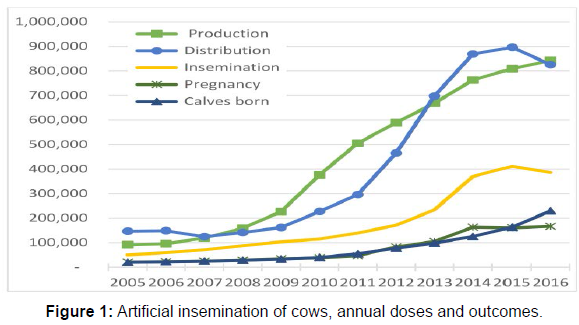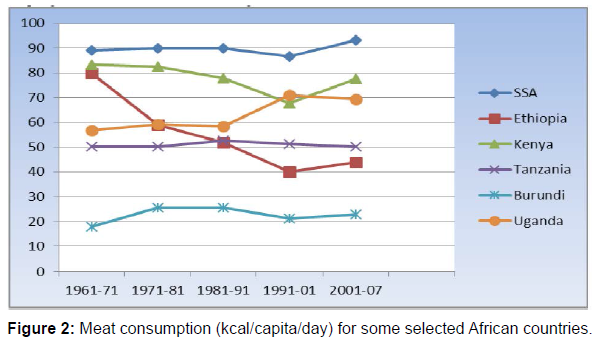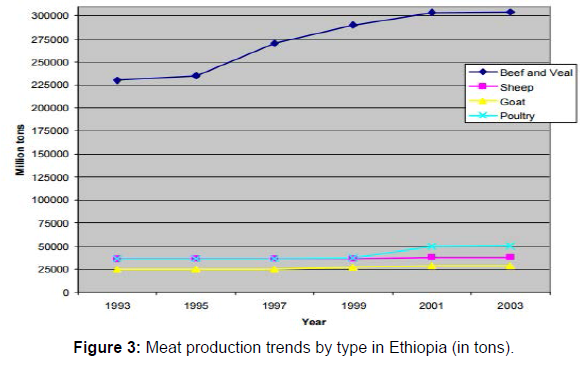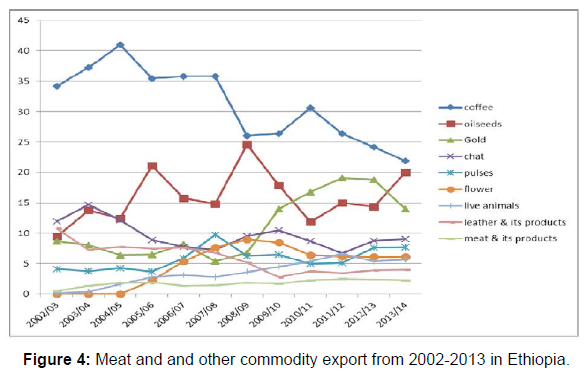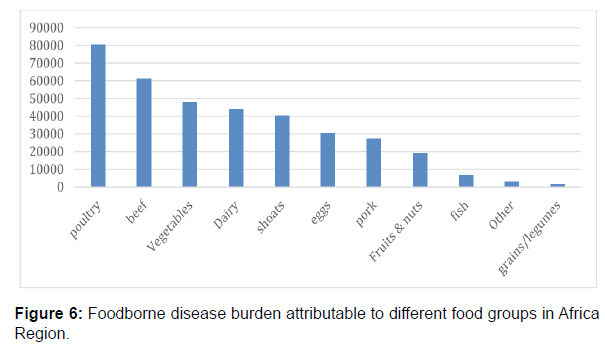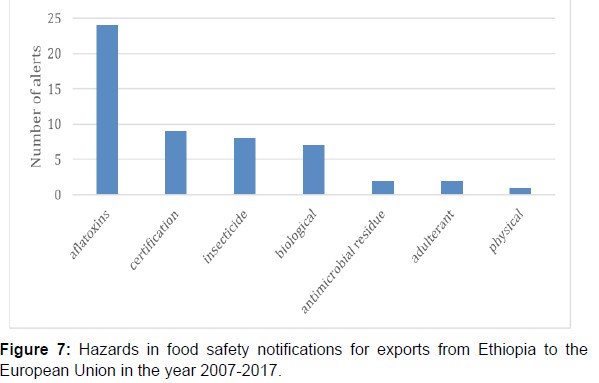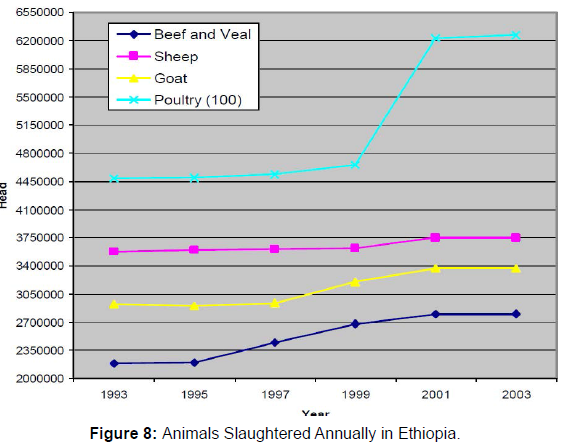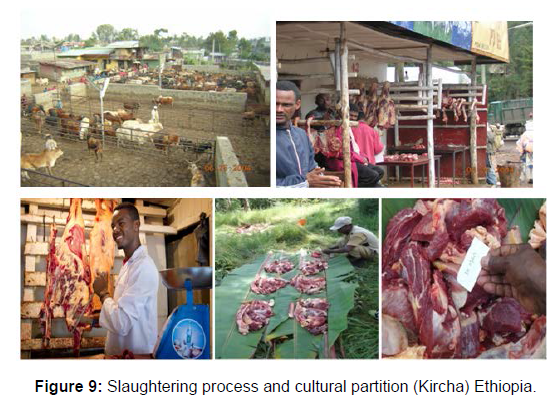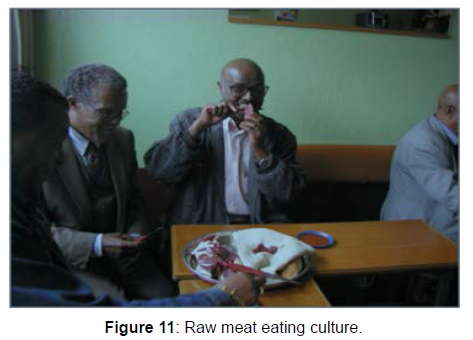Review on Beef Meat Quality and Safety in Ethiopia
Received: 01-Feb-2022 / Manuscript No. jbtbm-21-38004 / Editor assigned: 03-Feb-2022 / PreQC No. jbtbm-21-38004 / Reviewed: 17-Feb-2022 / QC No. jbtbm-21-38004 / Revised: 21-Feb-2022 / Published Date: 28-Feb-2022 DOI: 10.4172/2155-952X.1000260
Abstract
Ethiopia had largest livestock populations in Africa and tenth in the world. It contributes about 45% to the agricultural GDP, supporting the livelihoods of 70% of the population, 18.7% to the national GDP and 16–19% to the total foreign currency earning of the country. The country had high cattle resources potential, their productivity and quality earned of this resource is low. Attention is required to overcome the constraints that affecting beef eating quality attributes, like Pre and post- handling of animals and beef especially improvement of beef meat quality and controlling the safety concerns from food borne pathogens like E.coli, salmonella, Fecal coliform and staphylococci, Aflatoxin, molds and parasitic warms (C.bovis) is vital. Slaughtering techniques, Cold chain management, Handling of slaughter cattle in the abattoir and personal hygiene, environmental sanitation, Knowledge on food handling, educational status of the butcher shops workers among the predominant factors of contamination of the beef. For future work on Meat aflatoxin, meat veterinary drug residue should be the focused area. Therefore, implementations of GMP and HACCP principles as strategy should be adapted to control pathogenic microbes.
Keywords
Meat; quality; Safety and pathogen
Introduction
Livestock is an integral part of agriculture, accounting for about 45 percent to the total value of agricultural production and supporting the livelihoods of a large share of the population. The national herd comprises 57 million cattle, 30 million sheep and 23 million goats, and 57 million chicken, as well as camels, equines and a small number of pigs. Most animals are raised in the highlands, where also majority of the Ethiopians lives. Total production of milk, meat and eggs amounts to 5.6 billion litres, 1.1 million tones and 419 million eggs per year. Beyond providing foods and other goods and services to the population, the livestock sector is a major contributor to export earnings, mainly through the export of live cattle and small ruminants. It is estimated that Ethiopian livestock contribute about 10 percent to total export earnings, of which 69 percent accounted for by live animal exports but live animals sold illegally to Djibouti, Kenya and Sudan. The total supply of animal source foods in the country, including of net trade, translates in a per capital consumption of 9 kg meat, 56.2 liters of milk and about 4 eggs per year.
It contributes about 45% to the agricultural GDP, supporting the livelihoods of 70 % of the population, 18.7% to the national GDP and 16–19% to the total foreign exchange earning of the country. Meat is the most valuable livestock product and for many people serves as their first choice from animal protein which provides all the essential amino acids and various micronutrients in proper proportion to the human beings. This includes all processed or manufactured products prepared from animal tissues [1]. Meat production and consumption has important in the Ethiopian economy. The Ethiopian meat export volume increased from 7,916 tons in 1999/2000 to 19,104.7 in 2018/2019. The Country’s export performance reached its peak in 2016/17 by exporting 19,779.20 tons of meat. In the same period the meat export (chilled shoats, beef carcass and offal) value has picked up from 1.7 million USD to 92.65 million USD [2].
Because of low productivity and poor management systems practiced however, the average live weight of cattle is estimated at 250 kg; with 14% off take rates and 110 kg carcass weight at 44% dressing percentage. The off take rates for sheep is 40% that of goats 27% with 10 kg and 8 kg of carcass weight, respectively. The major and formal meat export destination from Ethiopian export abattoirs for chilled small ruminant meat is limited to United Arab Emirates and Kingdom of Saudi Arabia with the order of 60% and 38% share. The consumption of meat and meat products has a very tidy association with religious beliefs, and are influenced by religions. The main religions of Ethiopia have their own peculiar doctrines of setting the feeding habits and customs of their followers. This influence meat products consumption through dictating the source animals that should be used or not be used for food and scheduling the days of the years in periodical permeation and restriction on consumptions which in turn influences the pattern of meat consumption in the country. In Ethiopia, a cow or an ox is commonly butchered for the sole purpose of selling within the community. In special occasions, people have a cultural ceremony of slaughtering cow or ox and sharing among the group which is called Kircha, which is a very common option of the people in rural area where access of meat is challenging frequently.
Trends of meat production and export in Ethiopia
According to CSA (2017) data the breed composition of cows and chicken, the only livestock types for which data is available on breed type. The data on breed type indicate that indigenous or local breed cows and chicken are dominant. Foreign cow breeds are almost nonexistent among smallholder farmers’ herds, while hybrid cows represented only 1 and 2 percent of the total number of cows in 2004 and 2015, respectively. However, it is to be noted that artificial insemination is increasingly being adopted in the livestock sub sector of Ethiopia. Figure.1 shows the evolution in the production, distribution, insemination, pregnancy, and calves born using artificial insemination. The number of calves born using artificial insemination was 11 times higher in 2016 than in 2005. However, only 230,000 calves were born through artificial insemination in 2016, still a small number compared to the total cattle population (Figure 1).
In Africa annual meat production from ruminants was 7.5 million tones, of which 65% was from cattle, 32% from small ruminants and 3% from camelids. African continent accounts for about 4% of the world production of animal products and its share in world trade in animal products is less than 1% and its meat consumption (kcal/capita/day) between 1961-2007. Uganda, Burundi and SSA the per capital calorie consumption from meat is in the increasing trend whereas for Ethiopia there is a sharp decline. For the remaining countries listed, the per capital kcal from meat consumption is almost constant across the years. Citizens from developed countries consumed a consistent level of 77 kg of meat per capital annually, while developing countries struggled to maintain a diet with only 25 kg of meat per capital annum. The fast growth of Ethiopian economy and population, the domestic demand for meat is increasing; however, the country is among the lowest per capital meat consumption in the world which is 8 kg, of which about 5.3 kg comes from beef (Food and Agricultural Organization Statistics, 2015). Ethiopia is the tenth largest livestock population in the world; the production of meat is still low and contributed to about 0.2 percent of the world total meat production, of which most is sheep and goat meat. The total meat production in Ethiopia increase from 578,240 tons in 2004 to 749,430 tons in year 2014 and decreased to 596,765 tons in year 2017 (Figure 2 and 3).
Food borne illness and microbial contaminants of fresh meat
Most cases of food borne illness are a result of pathogens in food. Pathogens are microorganisms that can cause illness in humans. The pathogens that cause food borne illness do not necessarily cause undesirable changes in food. Many times, pathogens cause a food to be unsafe to eat before there are any visible signs of spoilage. Pathogens can cause illness in one of three ways: intoxication, infection or toxic infection [3]. More than 40 food borne microbial pathogens are known to cause human illness, including bacteria, parasite, viruses, fungi and their toxins. Several pathogens were recognized only recently as a cause of food borne illness. Some food borne pathogens have not yet been scientifically identified (Figure 4). Meat is any solid food and meat has contributed substantial role in the human diet. Though denied by some on moral or religious grounds, meat eating still remains widely popular. This is due to the fact that it has desirable texture and flavor characteristics; beside meat protein does also have a high biological value. Meat from cattle, pigs, sheep, goats and poultry are among animals of principal importance in economic. Meats are the most perishable of all major foods. Meat contains an abundance of all nutrient required for the growth of bacteria, yeast and molds and an adequate quantity of these constituents exist in fresh meats.
In general, the biota is reflective of the slaughtering and processing environments with bacteria being predominant. The presence of the more varied biota on non-spoiled meats, then, may be taken to represent the organisms that exist in the original environment of the product in question or contaminants picked up during processing, handling, packaging, and storage. When microbial numbers of fresh meat reach around l07cfu cm-2, it produces off odors. This is signal of spoilage of fresh meat. At this point it is believed that the microorganisms switch from the diminishing levels of glucose in the meat to amino acids a substrate for growth. In meat with lower levels of residual glucose this stage is reached earlier (l06 cfu /cm2) and this accounts for the earlier onset of spoilage in high pH meat. At final spoilage stage form of a visible slime surface on the meat is one sign. This stage is happened when microbial numbers reach levels of around 108cfu cm-2 . Diarrhoea diseases are the most important contributor to the overall burden of foodborne disease in African region followed by helminthes and invasive bacteria. Chemical hazards and toxins are relatively un important, with the burden more or less equally shared between aflatoxins (Figure 5).
Pathogens isolated from foods in seven African countries showed that E. coli, Salmonella, S. aureus and L. monocytogenes were the major pathogens in foods and worryingly bacterial contamination of readyto- eat foods was as high as the raw foods. Prevalence was highest in Uganda followed by Nigeria (then Sudan, Benin, Kenya, Ghana and Botswana in declining order) shown in Table 1. Overall, animal source foods are the most important sources of food borne disease followed by produce (fresh fruit and vegetables) shown in Figure 6. From the report from the European Union on export rejections between January 2007 to October 2017 (Figure 7). Over this period, Nigerian food accounted for 373 alerts, Ethiopian for 53 reports and Burkina Faso for only 7. In Ethiopia and Nigeria, the most commonly detected hazards found aflatoxins and in Burkina Faso is Salmonella.
| Pathogen | Meat | Milk | Fish | Veg’s And Fruits | Ready To Eat |
|---|---|---|---|---|---|
| Escherichia coli % | 49 | 40 | 38 | 60 | 36 |
| Staphylococcus aureus % | 49 | 35 | 31 | 30 | 21 |
| Entero bacteriaceaea % | 31 | 25 | 38 | 40 | 39 |
| Salmonella % | 47 | 10 | 38 | 30 | 18 |
| Bacillus spp.% | 18 | 10 | 8 | 20 | 18 |
| Listeria monocytogenes % | 13 | 15 | 8 | 40 | 4 |
| Average % | 34 | 23 | 27 | 37 | 23 |
Table 1: Pathogens identified in different types of food in seven African countries.
Pre slaughter transport and handling, meat hygiene and eating culture in Ethiopia
Slaughtering takes place at official slaughterhouses throughout the country in most animals for Addis Ababa residents are slaughtered at the Addis Ababa Abattoirs Enterprise. The number of slaughtering animal shown in (Figure 8). It is clearly best practice to minimize preslaughter stress. Thus cattle should be loaded on the farm, transported, unloaded at the abattoir and delivered to the point of stun with the minimum of stress and risk of physical damage to the animals. In the last few years there have been papers showing that there is an effect of animal temperament on eating quality and animals showing nervous behavior have higher shear force than calm or simply restless animals. Mixing can also be associated with tougher meat indicated that, if cattle put under stress in the period between the farm and abattoir, they may produce dark, firm, dry (DFD) beef. This is because muscle glycogen stores are mobilized by stress hormones, leaving a low concentration of glycogen in muscle at slaughter and a correspondingly low fall in muscle pH post mortem. Muscle pH in longissimus 48hr after slaughter (ultimate pH) is typically 5.5 in normal cattle. The problem of dark, firm, and dry beef is much more common in bulls than in steers or heifers. As ultimate pH increases, the desirable flavors associated with cooked beef tend to decline. In holidays, people have a cultural ceremony for slaughtering cows or oxen sharing among the group called kircha, which is a very common option of the rural areas where access of meat is challenging. Kircha is a form of people’s organization and sharing meat among themselves butchering live animal and sharing the meat in group. Kircha is considered by Ethiopians as their social capital. The style is also common in some of Ethiopia towns’ people by which the elders especially enjoy being involved in the activity. On holidays, neighbors join together into kircha to buy a large ox and equally divide it then draw lots to decide which pile they get. It is cheaper than going to the butcher. According to kifleyesus the meat is divided on the basis of equal portions comprising a package of every internal organ, muscle meat and bones of the slaughtered animal. Meat safety from slaughter to resale, there is no formal classification of carcass quality. The butcheries stored their meat in a room temperature, open air environment display (Figure 9 and 10).
Most customers bought raw meat to prepare and consume within their home. At the larger butcheries, however, many frequently sit at makeshift tables and devour the traditional meal of raw meat or kitfo (Figure 11). Reported the hygienic practices assessed in cattle slaughterhouses (28 employees) and retail shops (127 employees) through face to face interviews and direct personal observations in Bishoftu. At the slaughter houses, stunning, de-hiding and evisceration in vertical position, carcass washing and separate storage of offal the identified good practices. Lack of hot water baths, absence of a chilling rooms, infrequent hand washing, insufficiently trained staff and irregular medical checkup were practices lead to unhygienic handling of carcasses. About 40% of slaughter houses and 85.8% of retails shops employees did not receive training on hygienic handlings of meat and all employees at the slaughterhouses and 98% of the respondents at retail shops confirmed having had a medical checkup.
At the retail shops, cleaning equipment using soap and hot water (81%), storing unsold meat in refrigerators (92%), concrete floors and white painted walls and ceilings were good practices. But lack of a cold chain, wrapping meat with plastic bags and newspapers, using a plastic or wooden cutting board (57%), infrequent washing of equipment and floors, and inadequately trained employees practiced that could result in unhygienic handling of beef. Previous studies also reported that a considerable proportion of meat processing employee’s and meat retail shops employees did not receive basic training on hygienic handling of meat. This is contrary to the basic requirements for working in the food industry. Employees working in food establishments such as slaughterhouses and retail shops should be trained on food safety issues. In general the study report identified unhygienic practices both at the slaughterhouses and retail shops that can predispose the public to meat borne infections, which could be improved through training and implementation of quality control systems.
Seifu and Sentayhu reported by assessment of human resource capabilities, sanitation of slaughter houses and processing materials. Observation survey undertaken at all slaughter houses and meat stalls while interview data collected from 54 slaughter house butchers. At Bure, Debremarkos, Dejen and Fenoteselam respectively from April to August 2017. According to the servy slaughter house workers not professionally trained and certified. Most of them are not used aprons, hair cover and gumboots and all had no overall cloth. The entire abattoirs had no clear division for slaughtering process, which undertaken simply on the ground and hanging were take place on simply constructed wood. Relatively Debremarkos (46.15%) abattoir had better sanitary standard and followed with Fenoteselam (23.08%), Bure (15.38%) and Dejen (7.69%). This finding likewise with the research undertaken on assessment of hygiene practices used by small butchers and slaughter slabs in Juba town South Sudan and the assessment on hygienic conditions and sanitation practices of slaughterhouses of Jagdalpur city in India [4] . In addition according to the most of the butcher’s dose not taken professional training and had not used apron and hair cover. However personnel must be equipped with the materials and equipment necessary to perform tasks. It has important role in the production of safe foods.
Beef eating quality standard in Ethiopia
Meat quality refers to the compositional quality and the palatability of meat. The major parameters considered in the assessment of meat quality are appearance, juiciness, tenderness, and flavour. Tenderness, flavor and juiciness are the important palatability characteristics to evaluating eating quality of beef. Countries have established the system that best allows consistency of product for their consumers. Such standards have not been developed fully in Ethiopia. The first and foremost step in this direction is to have data on various parameters of quality of meat, which is lacking in Ethiopia (Table 2).
| Parameter | Requirement |
|---|---|
| 1.plate count | 2 x 10-5 |
| 2.coliform | Nil |
| 3. Clostridium perfringens | Nil |
| 4. Staphylococcus | Nil |
| 5. Salmonellae | Nil |
Table 2: Chemical requirements for corned beef.
Physicochemical quality of beef meat in Ethiopia
The Eating Quality Attributes of beef meat are Tenderness, Juiciness and Flavor. Tenderness is one of the most important meat palatability attributes and consumers are willing to pay more for beef which is tender, Juiciness refers to the quantity of apparent juice that comes from meat during chewing, Flavor represents the interaction between aromatic compounds within the nasal cavity and chemical compounds that contact the tongue during eating. Study report on the eating qualities of beef meat collected from Arsi, Borana, and Harar Cattle breeds using a total of 39 samples in Ethiopia. The tenderness with beef from Harar and Boran bulls very tender (18.5 - 20.34) respectively while beef from Arsi bulls intermediate in tenderness (40.6). Beef from Harar and Boran breeds very tender. Flavor from Harar and Boran breeds moderately liked while flavor from Arsi liked slightly. Beef from Boran breed juicier than beef from Harar and Arsi breed. According to this study in agreement with the present study high sensory beef tenderness (5.43) reported in South Africa. The normal ranges for beef water holding capacity research has reported ranges 37.0 − 72.7 % considered as normal. The mean lightness coordinate of the three breeds lied between 30 and 35 while the mean redness and yellowness lied between 10 and 15. The result of the present finding agreed with other reports who did not found any variation in color values between bulls and steers of different breeds.
According to Gebrehiwot report a total of 80 samples used for the study from 80 randomly selected butcher shops in mekele sampled in 6 months study period of time, from May to October, 2017. In the study, it found that 65% of the animals slaughtered old whereas 35% young agrees with the report of Legese. That 64.4% of the animals slaughtered at Mekelle abattoir old in age. The result of filter paper press of the study with the mean value of 49.4% of dark colored meat that agreed with the reports of Gunenc that had shown with mean value of 48.75% Miller also reported similar findings of dark colored meat with higher dark form dried meat (DFD). These indicated that the low water holding capacity of the meat could cost butchers house significantly which also supported by Huff-Lonergan. The pH at 3 hour post slaughter recorded 6.1 to 6.6. This is comparable with the work of Lundesjo Ahnstrom who recorded 6.1 to 6.37. The age of the slaughtered animals had significant association with the pH measured at 24 h post slaughter, drip loss and filter paper press measurements. The pre-slaughter rest period had strong effect on pH at 3 h post-slaughter. The study concluded that water holding capacity and pH as quality indicators of meat are influenced by age and pre-slaughter rest of the slaughtered animals.
According Birmaduma study report evaluated eating qualities of beef produced at public abattoirs from Arsi, Bale and Harar cattle breeds. The samples collected from the longissimus dorsi region within 45 min after slaughters. The eating quality using panel testing. Mean values of 33.12 N, 7.12, 7.2 and 7.24 determined in instrumental tenderness, sensory tenderness, juiciness, and flavor of beef respectively. The instrumental tenderness had negative medium relationship with sensory attributes conducted for tenderness and juiciness, but positive with flavour. From the study, it concluded that quality of beef produced in study areas relatively tender which internationally competent but becomes tough as cattle gets older. It is recommended that strategy should be developed to encourage premium payment for young cattle marketing that is not exposed to draft service and creating awareness among stakeholders on quality beef production. As Ethiopia is planning to in the beef market in the Middle East Countries, it is highly needed to promote Ethiopian beef at international markets.
According to Dagne report the study determined proximate composition and profile of fatty acid of beef from Arsi, Borana and Harar Cattle breeds in Ethiopia. A total of 39 bulls with three age categories considered for the study. The bulls purchased from mixed crop livestock system (Arsi and Harar cattle breeds) and Ranch (Borana cattle breed). Longissimus dorsi muscle used to evaluate proximate composition and profile of fatty acid. The result of the study indicated that mean of percentage of dry matter, ash, crude fat and crude protein were ranging 22.43 - 24.26, 0.32 - 1.28, 4.32 - 7.88, 17.21 - 22.76, respectively. The concentration of polyunsaturated fatty acid (PUFA) had higher than saturated fatty acid (SFA) in the three breeds studied across all age categories. Ratio of n-6: n-3 in the muscle of bulls under the study had ranged from 2.10 to 2.57.
A study had reported the presence of significant difference in protein, fat, ash and moisture content of beef across the breeds. Besides, another study had reported difference in fatty acid compositions between breeds. The crude fat content of beef of all the breeds under the study can be considered as a good contributor to palatability of the beef as minimum of 3% fat is suggested to ensure acceptable palatability of beef. From the study it concluded that Arsi, Boran and Harar bulls under the three age categories contained more than 3% minimum crude. The higher concentration of PUFA over SFA in all breeds across age categories indicated that the meat from these cattle breeds has less risk hazard to human health. However, a strategy needs to be developed to increase the ratio of n-6: n-3 to the nutritional Recommendations by the World Health Organization which is 4:1 to 5:1. According to Kumar and Kassaye report on physical quality of 83 samples of beef produced and marketed in some parts of Tigray region of Ethiopia evaluated. The color, marbling, pH, bleeding status within permissible limits in 35 (42.16%), 47(56.63%), 51 (61.44%), 13(15.66%) samples, respectively. Based on these parameters, a high percentage of samples (varying from 38.56%–84.34%) had unsatisfactory quality. Meat purchasing decisions are influenced by color more than any other quality factor because consumers take discoloration as an indicator of freshness and wholesomeness. Around 15% of retail beef is discounted in price due to surface discoloration which corresponds to annual loss of $ 1 billion. Obtaining a stable red color of beef is a challenge since the color is influenced by a number of internal and external factors such as levels of oxygen. Pre-slaughter stress, pH, storage of meat and the amount of the light to which the meat is exposed. Aerobic bacteria can also cause discoloration due to production of metabolic by products.
Fresh beef color can be achieved through improved sanitation and antimicrobial treatment, temperature control, packaging, diet modification, improved breeding and handling of live animals. Marbling has a significant influence on consumers’ perception of beef quality. The studies suggest that beef from the carcasses graded at least select beef grade are likely to be acceptable in eating quality. Imperfect bleeding affects the quality of meat as more blood in the meat makes it more prone to microbial multiplication which ultimately reduces the quality of meat.
Study report conducted at Werer agricultural research center from May 2014 to April 2015 with the objectives of evaluating different feed supplementation options for two years old Afar bulls to attain export market weight and investigating duration required for the purpose. A total of twenty one bulls with an average initial weight of 151.2 kg used for the experiment. Three different dietary feed ratios formulated used. Generally the feeding trial indicated that supplementation of 20% molasses, 35% wheat bran and 45% linseed cake after grazing to two years of Afar bulls enabled them to attain market weight of above 300 kg in 254 days. Reported conformation and fat grades of carcasses in the wet and dry season studied. Conformation of fat grade higher in the dry season (48.34%) with the average carcass weight of 99.38 ± 0.70 kg compared to the wet season (21.78%) with the average carcass weight of 138.98 ± 1.01 kg observed in the wet season. The explanation made for the difference in carcass weight between the wet and dry seasons hold true for the difference in conformation and fat grade between seasons. The finding in the study further indicated the needs to develop strategy of supplementing cattle in the dry season to produce higher yield and quality carcasses.
According to Agmas study report the prevalence and its public health risk of antimicrobial residue in fresh beef meat at Bahir Dar and Debre Tabor towns, Northwest Ethiopia. The result of the study showed that beef farms 42 (97.67%) using tetracycline (oxytetracycline). In addition to β-lactams, (pinstripe) 21 (48.84%), and sulfonamides drugs including sulfadimidine and diminazene accentuate each 4 (9.30%). The study had similar high result with studies that conducted on antimicrobial residue test on the beef meat samples in central parts of Ethiopia; Addis Ababa, Debre Zeit and Nazareth slaughterhouses, (93.8%), (37.5%) and (82.1%) positive for oxytetracycline and antimicrobial residue records in beef meat such as Nigeria 54.44%, Kenya 45.6%, Ghana 30.8%, and Sudan 17.33%. No one beef farm has respected drug withdrawal period and lack of awareness about antimicrobial side effects in 37 (86.05%) farms. Among 250 beef cattle slaughtered, antimicrobial residue positivity were 191 (76.4%) giving a 95% confidence interval of 71.10-81.70% origin of beef farm. In general the Prevalence of antimicrobial residue in beef meat in Bahir Dar and Debre Tabor towns had high and also the drug residue detected higher than the standard level (Figure 12).
According to Bededa report a cross sectional study conducted from October 2006 to May 2007 to estimate the proportion of tetracycline residue levels in beef at Addis Ababa, Debre Zeit and Nazareth slaughterhouses in central Ethiopia. From 384 muscle and kidney samples randomly collected from slaughtered cattle in the respective slaughter houses. The samples qualitatively screened for tetracycline residues by thin layer chromatography (TLC) and using high performance liquid chromatography (HPLC). Out of the total 384 samples that analyzed for tetracycline residues, 71.3% (274/384) had detectable oxytetracycline residues. Tetracycline and doxycycline residues not detected in any of the samples analyzed. Among the meat Beef producers use hormonal growth promotants because they improve meat quality by increasing the development of lean meat and decreasing fat content increase feed efficiency thereby allowing more growth with less feed reduce costs for producers thereby reducing the price of meat and meat products for consume beef production in Canada competitive with other beef producing nations (Canadian Cattlemen’s Association and Beef Information Center, 2001). Along with increasing in live weight due to high growth hormone treatment, there is a corresponding increase in dressed carcasses weight. Carcass implanted with hormonal growth promoters has a higher ossification score but a 10 to 15% lower marbling score. The reasons for reduced marbling scores are unclear. Some have proposed that implantation of hormonal growth promoters early in an animals’ life could delay the deposition of marbling, whereas others consider that it is due to the stimulation of increased protein deposition which effectively dilutes the fat content within the muscle. Meat from high growth hormone treated animals does not improve as quickly during ageing, so an additional period may be required. Tender stretching (hanging by the aitch bone or sacrosciatic ligament) during chilling has been shown to provide great improvement in the tenderness of certain primal cuts. This will largely offset the effects of high growth hormone treatment on carcass quality (Tables 3 and 4).
| Parameter | Requirement |
|---|---|
| 1. Total protein, % by mass min | 21 |
| 2. Ash, % by mass max. | 3 |
| 3. Sodium nitrite, mg/kg | 50 |
| 4 .Lead ,as (Pb) mg/kg | 1 |
| 5. Arsenic ,(As) mg/kg | 1 |
| 6 .Tin ,as (Sn) mg/kg | 200 |
Table 3: Microbiological requirements for corned beef.
| Residue | Threshold level(mg/kg) | Health effect on human |
|---|---|---|
| 1. Oxy tetera cycline | 0.6 | Developing multidrug resistance, disruption of intestinal normal microflora |
| 2. Penicillin G | 0.05 | Developing multidrug resistance and disruption of intestinal normal microflora |
| 3. Albendazole | 5 | Developing multidrug resistance, disruption of intestinal normal microflora |
| 4. Isomethamidium | 1 | Developing multidrug resistance, disruption of intestinal normal microflora |
| 5. Thiabendazole | 0.1 | Developing multidrug resistance, disruption of intestinal normal microflora |
| 6.DDT | 0.13 | Carcinogenicity |
Table 4: Chemical residue (Veterinary Drug and pesticide residue).
According to study report in Adama town, on carcass samples collected from the Arsi breed of cattle with the objective of evaluating beef microbiological qualities with standard procedures. On the night carcass sampling about 125 cattle slaughtered and the carcass samples chosen on every 10 counting. Beef samples aseptically excised and collected from all parts of the exposed body of carcasses. The mean AP, Total coliform, Fecal coliform, E. coli and staphylococci counts as 1.62×105 , 5.29×101 , 9.05×101 , 8.97×101 and 5.54×105 respectively. All counts exceeded the established standard microbiological contents of beef set by different countries. This report on AP is comparable with Mezegeb and moges that reported an aerobic mesophilic counts that ranged from 2×107 to 2×108 cfu/g in the traditional minced beef locally called ‘kitfo’. In general according to the study report Adama, carcasses are normally transported to the butchers’ shop either in vans, minibus, taxi, three wheel motor cycle and horse cart. This exposes the meat to a number of pathogens some of which may be pathogenic (Table 5).
| Residue | Number of sample | Location | Content (%) |
|---|---|---|---|
| 1. Oxy tetracycline | 42 | Bahir dar,Debere tabor | 97.67 |
| 384 | Addis Ababa | 93.8 | |
| 384 | Deberziet | 37.5 | |
| 384 | Adama | 82.1 | |
| 2. Pinstripe | 42 | Bahir Dar, Debere tabor | 48.84 |
| 3. sulfonamides drugs | 42 | Bahir Dar, Debere tabor | 9.3 |
| 4. DDT | 90 | Ambo, Guder, Ginchi, Gedo, Holeta | 2.16 mg/kg |
| 5.Endosulfan-I | 90 | Ambo, Guder, Ginchi, Gedo, Holeta | 0.025mg/kg |
| 6.Lindane | 90 | Ambo, Guder, Ginchi, Gedo, Holeta | 0.009mg/kg |
Table 5: Chemical Residue (Veterinary and Pesticide residue).
| Parameters | Number of sample | location | Content (%) |
|---|---|---|---|
| 1. Tenderness | 39 | Arsi, Harar, Borena | 38.5 |
| 45 | Aresi, Bale, Harer | 21.3 | |
| 45 | Aresi, Bale, Harer | 33.1 | |
| 2. water holding capacity | 39 | Arsi,Harar,Borena | 20.34 |
| 80 | Mekele | 6.22-7.3 | |
| 3. Redness | 39 | Arsi,Harar,Borena | 37-72.7 |
| 80 | Mekele | 5.8-5.9 | |
| 83 | Adegrat.michew,mekela,wekro | 42.17 | |
| 4. PH | 80 | Mekele | 48.4-51.1 |
| 83 | Adegrat, michew,mekela,wekro | 5.6-7 | |
| 5. Juiciness | 39 | Arsi,Harar,Borena | 6.5-8.2 |
| 45 | Aresi, Bale, Harer | 7.12 | |
| 6. Flavor | 39 | Arsi,Harar,Borena | 10.65-12.46 |
| 45 | Aresi, Bale, Harer | 7.2 | |
| 7. Lightness | 39 | Arsi,Harar,Borena | 11.57-14.02 |
| 8. Yellowness | 39 | Arsi,Harar,Borena | 28.81-38.15 |
| 9. Dry matter | 39 | Arsi,Borena, Harer | 22.4-24.2 |
| 10. Ash | 39 | Arsi,Borena, Harer | 0.32-1.28 |
| 11. Fat | 39 | Arsi,Borena, Harer | 4.32-7.8 |
| 12. Protein | 39 | Arsi,Borena, Harer | 17.2-22.76 |
| 13. Ratio of n-6 to n-3 | 83 | Adegrat,Michew,mekelle, wekro | 2.1-2.57 |
| 14. Marbling | 83 | Adegrat,michew,mekelle, ekro | 14.46-43.3 |
| 15. Bleeding | 83 | Adegrat, michew,mekelle,wekro | 15.56 |
Table 6: Physico chemical quality of meat.
| Parameter | Number of sample | location | Content (%) |
|---|---|---|---|
| 1. E .coli | 505 | Jima | 20.20% |
| 320 | Dirdawa and Haramaya university | 36% | |
| Addis Ababa | 29.55% | ||
| 124 | Bishoftu | 35.20% | |
| 2. Salemonela | Adama | 9.80% | |
| 124 | Bishoftu | 9.90% | |
| 320 | Dirdawa and Haramaya university | 2.75% | |
| Addis Ababa | 3.40% | ||
| 3. E.coli O157H7 | 320 | Dirdawa and Haramaya university | 2.06% |
| 4. Shegela | Adama | 2.67% | |
| 5. Aerobic count | 124 | Bishoftu | 6.58% |
| 6. S. aureus | Addis Ababa | 28.41% | |
| 7. C.bovis | 384 | Adama | 2.60% |
| 406 | Hawasa | 5.91% | |
| 405 | Debere Birhan | 5.43 | |
| 8. Hydatid cyst | 406 | Hawassa | 73.65% |
| 9. Fasciola spp. | 406 | Hawasa | 37.19% |
| 10.Taeniasis | 405 | Debere berhan | 4.30% |
| 11.Yeast | 30 | Jijiga | 4 cfu/g |
| 12. Mold | 30 | Jijiga | 4 cfu/g |
| 13.Aflatoxin | Survy from developing country | <10ppb |
Table 7: Microbial safety of beef meat in different part of Ethiopia.
According to study report the prevalence of E. coli isolated from raw meat samples of cattle origin conducted in Dire Dawa city, Ethiopia, from November 2012 to April 2013. A total of 384 meat samples collected from two abattoirs and cultured for detection of E. coli. Comparison on the prevalence of the bacteria made in relation to source (Dire Dawa ELFORA abattoir and Dire Dawa Municipal abattoir), site (neck and breast area, fore and hind limbs and lower back areas) and period (holidays and non-holidays) of meat sample collected. The investigation revealed a 15.89% overall prevalence of E. coli in the meat samples. Load of E. coli at ELFORA (17.29%) and Dire Dawa Municipal (24.48%) abattoirs. Abattoir alone, the prevalence (24.48%) of E. coli was With regards to the site of sample collection, a slightly higher than the report of. The neck and breast area found to be the highly contaminated site (29.95%) followed by lower back area (17.52%), for limbs (11.49%) and hind limbs (7.14%), respectively. Contamination of carcass with E. coli recorded during holidays (30.77%) than non-holidays (13.55%). The marked considered such as source of meat, site of collection on difference in prevalence of E. coli between the two the carcass and period of sample collection. In general, periods could be ascribed to the large number of animals the poor sanitary conditions during meat processing slaughtered during holiday events that can cause work appear to highly contribute to carcass contamination by overload on abattoir workers with a consequence of E. coli.
According to study report a total of 30 beef meat samples collected from vendors in Jijiga town. The samples held in a temperature range of 17.5-27.5°C. Total mesophilic bacteria, Entero bacteriaceae and coliforms, Staphylococci, lactic acid bacteria, yeasts and moulds had counts of >7, 4, 6, 4 and 4 log cfu/g respectively. The aerobic plate counts dominated by Staphylococcus spp. followed by Enterobacteriaceae. Salmonellae also isolated from 5 (8.3%) meat samples. Jewelries observed especially on vendor‟s hand were very high (70%) as compared to street food vendors assessed in other areas of Ethiopia such as Mekele (35.7%) and Awassa (28.7%). Hands are the most important vehicle for the transfer of organisms from faeces, nose, skin or other sites to food (WHO, 1984). Trainings, inspections, infrastructures and code of practice are recommended.
According to study report on raw meat the presence of E. coli from meat of cattle and swab samples at abattoir houses and butcher shops in Jimma town, Southwest district of Ethiopia. Out of 505 samples, 102 (20.2%) and 27 (5.4%) positive for E. coli and E. coli O157:H7, respectively. Among these, 55 (19.3%) and 47 (21.4%) of E. coli and 17 (6.0%) and 10 (4.5%) of E. coli O157:H7 had isolated from the abattoir and butcher shop samples, respectively. Another study report showed that the overall prevalence of E. coli O157: H7 was 31.20% in Africa and 1.65–7.35% in other continents. All abattoir and butcher shop workers did not have any formal education or training certificates on food safety and unhygienic practices also observed. In general the presence of E. coli in raw meat highlights how the current meat processing and distribution practice was unhygienic. Therefore, strategies in the prevention and control of food borne infections that could be caused by multi drug resistant strains will depend greatly on hygienic processing and distribution practices of meat.
According to study report the bacteriological load of raw meat and associated factors among butcher houses of Adama town, Ethiopia, 2019. The average contamination 5.89 log Colony Forming Unit per gram for total aerobic plate count. Whereas, proportion of meat samples were positive for Salmonella and shegella were (9.8% and 2.67%) respectively. According to food and agricultural organization total aerobic plate counts exceeding 5.0 log10 on fresh meat are not acceptable and alarm signals on meat hygiene. In general Bacterial logarithmic mean values were beyond the acceptable standard indication of poor hygiene, making it a potential source of food borne infection. Therefore, stringent inspection, regular supervision, training and hygienic practices should be introduced to enhance hygienic quality meat for consumers.
According to study report sample taken from bisheftu from November 2015 to November 2016 to determine bacterial load and identify pathogenic bacteria (S. aureus, E. coli, and Salmonellae species) in meat from abattoir and butcher shops. A total of 124 samples (48 swab samples from abattoir carcass, 4 samples of carcass washing water about 20 ml of each, and 36 swab samples each from butcher shop cutting table and cutting knife, respectively) collected during the study period. The collected samples processed for aerobic plate count, and the total mean count found to be 4.53 log10 cfu/cm2 from abattoir carcass swab samples, 2.4 log10 cfu/ml from water samples, 6.58 log10 cfu/cm2 from butcher shops cutting table, and 6.1 log10 cfu/cm2 from cutting knife swab samples. E. coli was the dominant bacterial species isolated (35.2%), followed by S. aureus (22.5%) and Salmonellae species (9.9%). According to the questionnaire survey, 48.4% (15/31) of the abattoir workers did not receive any training regarding food safety issues. Majority (66.67%) of the respondents of the butcher house workers were grade 1–4 (elementary) in their educational level and do not use hairnet and handle money with bare hands during serving meat to consumers. The study showed that the hygienic status of the abattoir and butcher shops in the study area is poor, and the obtained results of bacterial load are higher than the acceptable limit of the standard.
According to report samples collected in Dire Dawa city and Haramaya University slaughterhouses and retail shops to identify major food borne pathogens, assess the beef microbial safety and potential contamination risk factors. From 320 beef and environmental pooled samples examined for the presence of E. coli, E. coli O157:H7 and Salmonella in accordance with international standard guidelines. Among the 290 total beef samples collected, E. coli isolated from 36(12.41%) and of which 6(2.06%) E. coli O157 H7. On the other hand 8(2.75%) Salmonella spp. identified using culture and biochemical tests. The study indicated significantly higher fecal coliforms counts in beef samples from Haramaya University slaughter house (7.50 log10 cfug-1) than in carcass sample from Haramaya retail shop (4.80 log10 cfug-1). Out of 30 environmental pooled samples, E. coli, E. coli O157:H7 and Salmonella investigated in 7(23.33%), 2(6.66%) and 2(6.66%), respectively. In general from the visual observations slaughterhouse, hygienic practice employed, personnel habit found below the minimum standards. Therefore, good management and hygienic practices should be introduced in order to enhance the overall safety and hygienic quality of beef for the safeguard of consumers. The prevalence of E. coli O157:H7 isolated from beef in Haramaya university slaughterhouse (2.2%) and Dire dawa slaughterhouse (4%). The study is in agreement with the reported prevalence of 2.60% (mekonenen H et al.,2012) and 2.65% (Taye M et al., 2013) in Ethiopia. In comparison to the present study, a higher prevalence of E. coli O157:H7 reported from different countries; 8% in Debre Zeit and Mojo Hiko and 8.1% in Mojo, Ethiopia Meresha in India. The study showed lower prevalence of E. coli O157:H7 also isolated from Dire Dawa retail shop (1%) which is in agreement with the report from America (0.8%) Desenclos and Kenya (0.2%) Chapman According to study report the microbiological quality and safety of beef samples supplied to Gullele sub-city Addis Ababa assessed. The prevalence of E. coli, Salmonella and S. aureus in meat samples 29.55%, 3.4% and 28.41%, respectively. A comparative study done by Ejeta had reported 14.1% and 13.3% prevalence of Salmonella, which is higher than our study. In general the study report conclude the overall facilities slaughtering techniques, cold chain management, handling of slaughter cattle in the abattoir and personal hygiene, environmental sanitation, knowledge on food handling and educational status of the butcher shops workers were among the predominant factors of contamination of the beef.
According to study report A cross sectional study conducted in cattle slaughtered at Adama municipal abattoir in southwest Shoa zone of Oromia region to estimate the prevalence of bovine cystiercosis using routine meat inspection method and questionnaire surveys undertaken to assess the status of human taeniosis. Among 384 carcasses sample examined, 2.6% infected with Cysticercus bovis (C. bovis). Among positive cases for C. bovis, 78% viable while it was more prevalent in the tongue and triceps muscle (40%, 24%) than in the liver masseter muscle (10% 6%) respectively. Similar finding reported by Stata Corp. (2001) at Addis Ababa Abattoir. Based on the questionnaire survey, Taenia saginata (T. saginata) is a wide spread problem in Adama town where Out of 200 respondents 44% of the respondents had contracted T. saginata at least once in the past years which is close to the findings of Adugna. Among respondents 85% of them do have a knowledge that taeniosis is a zoonotic disease transmitted through consumption of raw beef meat. Improvement in meat inspection procedures and sanitary conditions as well as public education as to decrease negligence among public should get due attention.
According to study report the prevalence of major parasitic infections. The study conducted on cattle slaughtered at Hawassa Municipal Abattoir. Liver, lung, heart and kidneys the organs examined for the parasites and find that Fasciola spp.’s (37.19%)the main factors for condemnation of those inspected organs which shows that a lower prevalence fasciolosis observed when compared with following study like, Berhanu, Fistum, Gemechu and Shegaw reported a rejection rate of 54.8, 43.7, 53.9, 50, liver due to fasciolosis at Dire Dawa, Gonder, Haramaya and Addis Ababa abattoirs respectively, hydatid cyst (73.65%) which is higher compared with previous report made at the same study area with a prevalence 25.2% Andualem, 64.56% Fistum 24.3% Shegaw and Cysticercus bovis (5.91%). Among 406 cattle sample examined postmortem, 313 (77.09%) animals had at least one organ condemned due to the presence of helminth parasites. Fasciola spp.’s commonly found in animals with poor body condition (78.95%) as compared to medium (35.16%) and good (35.12%) body condition animals. Therefore, creation of awareness on animal attendants and/or cattle owners and abattoir workers about the effect of parasites and safe disposal of condemned organs must be needed.
According to reported a cross sectional study conducted in cattle slaughtered at Debre Brihan Abattoir from December 2016 to April 2017. Bovine cysticercosis and to estimate the prevalence of Taenia saginata human infection in and around Debre Brihan town, Central Ethiopia assessed. Patients’ demographic data and the results of stool examinations conducted using the formalin ethyl acetate concentration technique collected from records at Debre Brihan Referral Hospital. Among 405 sample examined carcasses, 22 (5.43%) found infected with various number of Cysticercus bovis in different organs which is comparable to the findings of Kifle and Shiret. Organ distribution of the cysts showed highest proportion observed in tongue, 7 (31.81%) followed by heart 6 (27.27%) in shoulder and masseter muscles 4 (18.18%) and 1 (4.54%) in liver. Among 2484 suspected patients, 97 (3.9%) stools positive for Taenia saginata eggs. The results obtained in this study shows the need for integrated community based control strategies such as continuous public education and improved standards of human hygiene together with restriction of backyard slaughtering of cattle are recommended in the study areas. Reported Aflatoxin B1 is metabolized to aflatoxin M1 (AFM1) in the liver and excreted in the milk of dairy cows. Because aflatoxins are degraded by flora in the cow’s rumen, the amount of AFM1 excreted in milk is only around 1–7 percent of the total amount of aflatoxin B1 ingested. Higher-yielding animals consuming large amounts of concentrates typically have higher levels in their milk. The presence of mastitis may increase the secretion of aflatoxins Trace levels of aflatoxins and their metabolites may also carry over into the edible tissue of meat producing animals. Poultry feed contaminated at the level of 3,000 ppb result in levels of 3 ppb in poultry meat. Aflatoxins may be carried over from feed to eggs at ratios ranging from 5,000–125,000 to 1. These transfer rates are much lower than for milk, and surveys in developing countries typically find levels of less than 10 ppb in meat and offal. Given the relatively low quantities of animal source food consumed, this is not likely to present a major contribution to overall consumption of aflatoxins in the diet.
Beneficial microbes in meat processing and preservation
According to [5] review report use of appropriately selected lactic acid bacteria reduce the risk of growth of salmonellae and other vegetative pathogens during sausage fermentation, and may contribute to the inhibition of Listeria monocytogenes on some perishable meat products. It appears to be possible to select strains that cause only little sensory alteration in the product. The most important mechanism of action n of protective cultures is the formation of lactic acid; the effect of bacteriocins is diminished by their inactivation in the meat, the possibility of resistance development in target organisms, and, in particular, the resistance of Gram-negative pathogens.
Conclusion
The country had high cattle resources potential, their productivity and quality earned of this resource is low. Attention is required to overcome the constraints that affecting beef eating quality attributes, like Pre and post handling of animals and beef, respectively. In general from all study report report conclude the overall facilities slaughtering techniques , Cold chain management , Handling of slaughter cattle in the abattoir and personal hygiene, environmental sanitation, Knowledge on food handling ,educational status of the butcher shops workers were among the predominant factors of contamination of the beef. Therefore, implementations of GMP and HACCP principles as strategy should be adapted to control pathogenic microbes which pose public health risks.
References
- Sebsibe A, Casey NH, Van Niekerk WA, Azage T, Coertze RJ, et al. (2007) Growth Performance and Carcass Characteristics of Three Ethiopian Goat Breeds Fed Grainless Diets Varying in Concentrate to Roughage Ratios. S Afr J Anim Sci 37 (4): 221–32.
- Tesfaye WB, Johannes ME, Melese AR, Ketema B, Haile Alemayehu, et al. (2014) Microbiological Quality and Safety of Street Vended Raw Meat in Jijiga Town of Somali Regional State, Southeast Ethiopia. Afr J Microbiol Res 8 (48): 3867–74.
- Zerabruk Kibrom, Negussie Retta, Diriba Muleta, Anteneh T (2019). Assessment of Microbiological Safety and Quality of Minced Meat and Meat Contact Surfaces in Selected Butcher Shops of Addis Ababa, Ethiopia. J Food Qual 69: 1-9.
- Lu Friedrich-karl (2000) Utilization of Microbes to Process and Preserve Meat. 56(2):105-15.
Indexed at, Google Scholar, Crossref
Indexed at, Google Scholar, Crossref
Indexed at, Google Scholar, Crossref
Citation: Kefale B, Satheesh N (2022) Review on Beef Meat Quality and Safety in Ethiopia. J Biotechnol Biomater, 12: 262. DOI: 10.4172/2155-952X.1000260
Copyright: © 2022 Kefale B. This is an open-access article distributed under the terms of the Creative Commons Attribution License, which permits unrestricted use, distribution, and reproduction in any medium, provided the original author and source are credited.
Share This Article
Recommended Journals
Open Access Journals
Article Tools
Article Usage
- Total views: 4778
- [From(publication date): 0-2022 - Apr 25, 2025]
- Breakdown by view type
- HTML page views: 4052
- PDF downloads: 726

